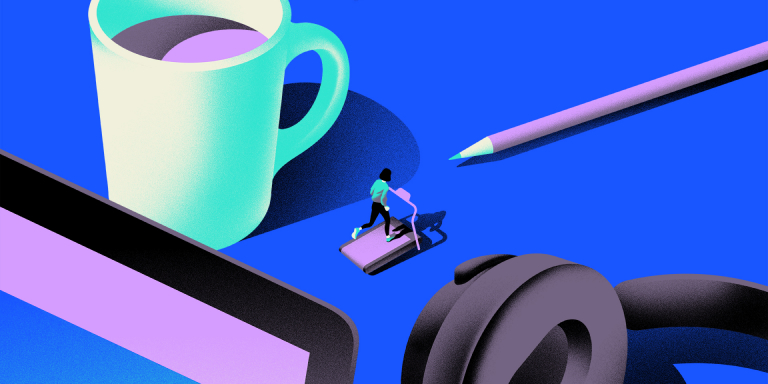Temitope “Temi” Ibisanmi is a born storyteller . At age 9, he picked up his first camera and became the designated documentarian of his Nigerian family. Later, while studying at Georgia State University, Ibisanmi spun tales through music as a campus DJ. Nowadays, this Brooklyn-based media campaign manager for Windows/Surface is still sharing a meaningful narrative.
Through his side project as a digital creator, Ibisanmi posts lush photos of his far-flung travels—think Zanzibar or Provence—on Instagram. “Through storytelling, I’m letting my audience see what it’s like to travel as a Black man—how welcoming the world can be toward us, and how accessible it is,” says Ibisanmi, who is one of the tens of millions of members of “the creator economy” who make and share content online. “When you have a passion project, it also expands your mind creatively.”
The creator economy encompasses a new breed of artists, writers, designers, and performers, along with the platforms that enable them to monetize what they create. Creators can monetize directly—by selling specific products online or doing sponsored posts on social media—or indirectly, for example by sharing content that helps them find opportunities like jobs or speaking gigs. Creators are gamers who’ve generated millions of dollars building worlds on Minecraft . They’re writers who cultivate an audience through digital newsletters. They’re comedians and beauty experts who reach fans on social media. They’re business leaders who provide insights and tips on LinkedIn. They’re people like Ibisanmi, who has a passion he wants to share with others as he collaborates with his partner, Skylar Marshai, on an Instagram account that has nearly 92,000 followers and generates income from sponsored posts.
Tapping into the creator community will open up opportunities as more people not only consume content but make it themselves—and make real money doing it.
Company leaders need to understand the creator economy because they have to keep up with their employees and where they’re at. And tapping into this community will open up new business opportunities as a wider swath of people choose to not only consume content, from videos to online articles to games, but to make it themselves—and make real money doing it.
Three opportunities for business leaders
For years, some organizations have viewed social media with skepticism, sometimes going so far as to block employees from accessing platforms during the workday. But with social media now more central to people’s lives, and with the creator economy growing fast, forward-looking organizations are focused on how to tap into this surge. According to CB Insights, companies in the creator economy received over $1.3 billion in investment funding in the first five months of 2021, triple the sum for all of 2020.
Here’s how business leaders can embrace this new reality:
Creators drive brand awareness . Kat Norton—better known as Miss Excel on TikTok, Instagram, and LinkedIn—makes funny video clips to share helpful tips and shortcuts with users of Microsoft’s Excel software. In the process, she’s racked up more than 1.1 million followers across platforms. She was recently named a Microsoft Most Valuable Professional for sharing her expertise with others. In the gaming realm, Microsoft’s XBox division partners with creators who get people excited about new consoles and game releases. In general, creators have become an essential part of the marketing funnel for companies of every size and industry; they help people discover brands and deepen their relationships with them.
Creators are a market for goods and services . Helping creators thrive is a big opportunity for businesses. For example, social networks and creators have a mutually beneficial relationship, with platforms from TikTok to LinkedIn growing as they find ways to help creators monetize their content or burnish their personal brands. Microsoft-owned LinkedIn rolled out an accelerator program for creators and is making a $25 million investment to help them build audiences. Creators are essential to LinkedIn because they share insights that spark discussion and engagement on the platform.
Creators unleash innovation within companies . Creators like Ibisanmi bring fresh ideas and perspectives to the organizations they work for. Doing creator work on the side can also help people learn new skills and advance their careers. Ibisanmi, for example, says his creator project, along with his enrollment into a part-time digital marketing MBA program, helped him grow at Microsoft. He was able to transition from account management into a marketing role he felt more suited to, becoming a media campaign manager.
Learning from Miss Excel
Kat Norton built a successful career as a creator by mixing spreadsheet tips with humor
Creativity, autonomy, and flexibility
When companies acknowledge and accept that employees have a side project, they show understanding that employees have a life outside the office. They signal awareness that people have nontraditional career paths and different needs, including the need for flexibility. Those are powerful messages at a time when employee retention is top of mind for many business leaders during the Great Reshuffle , as many people reevaluate what they want from their jobs.
Post-pandemic, people’s fastest-growing job priority is flexibility in when and where they work, according to a recent LinkedIn survey . Fifty percent of people say that’s more important to them now than it was before COVID-19. “The pandemic has shown us all that the traditional way that we have worked might not be the best way of working,” says Dan Roth, editor in chief and VP at LinkedIn. “We see this in all of our data at LinkedIn. There is this incredible demand for the ability to be able to carve out your own path and to have flexibility.”
With flexibility becoming a widespread expectation among employees, companies that don’t offer it need to consider that they’re not just competing with other organizations for talent—they also risk losing employees who might go off on their own, whether to start a business or join the ranks of creators.
“If you invest in your employees’ fulfillment, you get a better output of work from them.”
What’s the draw of becoming a creator? “You can say, ‘I’m able to express myself creatively, I’m able to choose for myself what I work on, and I have the flexibility to determine when I do that work, so long as I get it done,’” says Nancy Baym, a senior principal research manager at Microsoft who’s been tracking internet culture since the early 1990s. “Creativity, autonomy, flexibility—those are three values that can make an office job more appealing, too.” Baym, who is part of an initiative at Microsoft to study the future of work, says those are important signals for employers about what the next generation will want from their jobs.
‘Invest in your employees’ fulfillment’
Despite the upsides, experts say that being a creator is a demanding path that requires a special mix of skills, including entrepreneurship and an ability to go it alone, and that few people successfully make a living from it. Many people do creator work on the side while holding down another job or jobs, and they’re increasingly open about it.
“Even 10 years ago, you wouldn’t have dreamt of sharing your side project with your colleagues,” says Liz Gerber, an associate professor of design and co-founder and co-director of the Human Computer Interaction and Design Center at Northwestern University. “Now, it’s the norm.”
Gerber believes that creators motivate their colleagues as long as they get their core work done. “At the end of the day, not only does being part of this economy inspire creativity, but it also inspires a sense of belonging,” Gerber says. She adds that senior executives, too, can foster a creator sensibility in the workplace by talking about their own extracurricular interests like playing guitar or making jewelry. “By embracing creators, companies make their employees feel like they can bring their whole selves to work.”
Ibisanmi, the Microsoft employee with a side project as a creator, agrees. “If you invest in your employees’ fulfillment, you get a better output of work from them,” he says. “As I grow my moonlight project, I grow in Microsoft too.”

